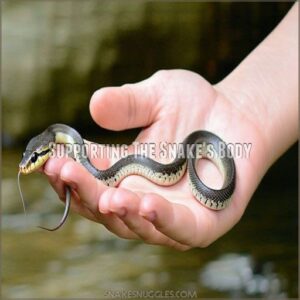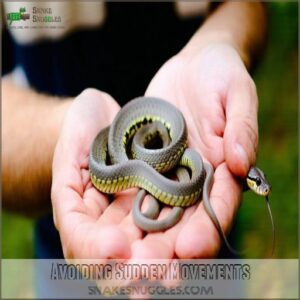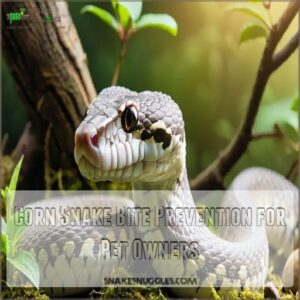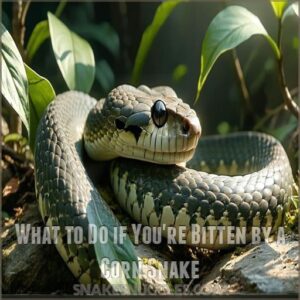This site is supported by our readers. We may earn a commission, at no cost to you, if you purchase through links.

Recognize stress triggers like hunger, shedding, and environmental changes that can make your snake defensive. Always support your snake’s body near the middle, move slowly, and avoid handling during sensitive times.
Keep their habitat comfortable with proper temperature and hiding spots. Wash your hands before handling, and learn to read their body language – a coiled position or raised head means "back off!"
By creating a calm environment and respecting your snake’s boundaries, you’ll minimize bite risks and build a trusting relationship. Curious about deeper snake-handling secrets?
Table Of Contents
- Key Takeaways
- Common Reasons for Corn Snake Bites
- How to Identify a Stressed Corn Snake
- Safe Handling Techniques for Corn Snakes
- Tips for Reducing Stress in Corn Snakes
- Preventing Corn Snake Bites
- Corn Snake Bite Prevention for Pet Owners
- What to Do if You’re Bitten by a Corn Snake
- How to Create a Stress-Free Environment
- Acclimating Corn Snakes to Handling
- Frequently Asked Questions (FAQs)
- How do you stop a corn snake from biting?
- What if you get bitten by a corn snake?
- What to do if a corn snake bites your pet?
- Can corn snakes bite through gloves?
- What happens if a baby corn snake bites you?
- What Should I Do if I’m Bitten by a Corn Snake?
- Are Corn Snake Bites Harmful?
- Are Baby Corn Snakes More Likely to Bite?
- How Do I Know if My Corn Snake is Stressed?
- Is There Anything I Can Do to Reduce the Risk of Being Bitten by a Corn Snake?
- Conclusion
Key Takeaways
- You’ll prevent corn snake bites by mastering their body language and recognizing early signs of stress, like defensive posturing or unusual hiding behavior.
- Your snake’s environment matters immensely – maintain proper temperature and humidity, and provide multiple hiding spots to keep your corn snake calm and reduce defensive reactions.
- When handling your snake, you must move slowly, support its body near the middle, and avoid sudden movements that might trigger a defensive bite response.
- You’ll build trust by limiting handling time (10-15 minutes, 2-3 times weekly), washing your hands before interaction, and respecting your snake’s boundaries during sensitive periods like shedding.
Common Reasons for Corn Snake Bites
Understanding why corn snakes bite is important for preventing unexpected encounters and maintaining a safe, positive interaction with these fascinating reptiles.
If you’re aware of the common triggers like stress, improper handling, and environmental discomfort, you’ll be better equipped to avoid potential biting incidents and build a trusting relationship with your scaly companion. Understanding why corn snakes bite is key to preventing bites and building a trusting relationship.
Stress Factors
Stress is the silent serpent lurking in every corn snake encounter. Understanding the root causes of snake anxiety can mean the difference between a calm companion and a defensive bite.
Key stress triggers include:
- Shedding periods increasing snake irritability
- Sudden environmental changes disrupting comfort
- Hunger-induced defensive responses
- Improper habitat conditions creating continuous tension
Recognizing these factors helps prevent unexpected defensive reactions.
Handling Techniques
Regarding corn snake handling, your approach can make or break the interaction.
Gentle, confident handling is key to preventing bites and building trust.
Support the snake’s body near the middle, keeping movements slow and predictable.
Respect the snake’s boundaries, avoid sudden jerks, and let it feel secure.
Calm, steady hands speak volumes in the snake world.
Environmental Factors
Inside your corn snake’s world, environmental factors can turn a calm reptile into a defensive biter.
Proper enclosure design is vital – make certain your snake’s habitat mimics its natural home with appropriate substrate, strategic hiding places, and carefully maintained temperature gradients.
A well-designed, comfortable environment reduces stress and minimizes the likelihood of defensive biting behavior. Environmental factors and proper enclosure design are key to a happy snake.
Hunger and Feeding Schedules
The rumbling stomach of a hungry corn snake can turn a calm reptile into a potential biter.
To avoid feeding-related stress, it’s essential to learn how to feed a corn snake.
Your feeding frequency matters – adult corn snakes typically need a meal every 10-14 days, while younger snakes require weekly feedings.
Match prey size carefully to your snake’s girth, using appropriately sized mice to prevent feeding-related stress and reduce bite risks.
How to Identify a Stressed Corn Snake
Recognizing when your corn snake is stressed is essential to preventing defensive bites and maintaining a healthy relationship with your pet.
By understanding their body language, behavioral changes, and environmental signals, you’ll be better equipped to identify and address your snake’s discomfort.
before it escalates into an aggressive response.
Body Language Signs
Reading your corn snake’s body language is like decoding a silent language of stress signals.
Watch for defensive postures: a tightly coiled body, raised head, flattened neck, or S-shaped striking position.
These subtle cues scream, "I’m uncomfortable!"
Defensive corn snakes might puff up their bodies, creating an intimidating silhouette to ward off potential threats.
Stay alert and respect their space.
Behavioral Changes
Watch for subtle shifts in your corn snake’s behavior that scream "I’m stressed!"
A normally docile snake might become defensive, coiling tightly or striking when approached.
Reduced activity, constant hiding, or unusual aggression during feeding can signal underlying tension.
Recognize these stress indicators early to prevent potential bites and keep both you and your slithery friend feeling safe and comfortable.
Environmental Changes
Spotting environmental stress in your corn snake requires a keen eye.
Your snake’s habitat dramatically impacts its mood and bite risk.
When temperature, humidity, or substrate changes, watch for agitation signals. Sudden shifts in enclosure size or layout can trigger defensive behavior.
Maintain consistent, comfortable conditions to keep your slithery friend calm and reduce the likelihood of unexpected nips.
Safe Handling Techniques for Corn Snakes
If you want to handle your corn snake safely, you’ll need to master a few key techniques that prevent stress and potential bites.
By supporting the snake’s body correctly and moving slowly and confidently, you’ll build trust and minimize the risk of defensive reactions.
Supporting The Snake’s Body
Supporting your corn snake starts with understanding its delicate body language and providing secure, confident handling.
Gently cradle the snake’s midsection with both hands, ensuring you’re supporting its full weight without squeezing.
This technique prevents potential escape attempts and helps your snake feel safe and reduces stress, making bite prevention a natural outcome of proper, respectful interaction. Proper handling is key to a safe interaction.
Avoiding Sudden Movements
A snake’s world moves in slow motion, so your lightning-fast reflexes can send it into panic mode.
Sudden movements trigger a corn snake’s defense mechanism, transforming a calm interaction into a potential bite scenario, often due to stress, improper handling, or fear causes of corn snake bites.
Move like you’re underwater – deliberate, smooth, and predictable.
Your gentle approach signals safety, helping your slithery friend feel secure and reducing the likelihood of a defensive strike.
Tips for Reducing Stress in Corn Snakes
Understanding your corn snake’s stress triggers is essential for preventing bites and maintaining a healthy relationship with your pet.
By creating a calm, enriching environment and minimizing handling during sensitive periods, you’ll help your snake feel secure and reduce the likelihood of defensive behavior.
Providing Environmental Enrichment
At the core of every corn snake’s world, environmental enrichment becomes your secret weapon for reducing stress and preventing bites.
Creating a snake-friendly habitat isn’t just about space—it’s about building a sanctuary that feels like home.
As you design this space, consider incorporating elements that support thermal gradients for exploration.
- Install climbing structures that mimic natural terrain
- Provide multiple hiding spots in different enclosure areas
- Use varied substrate types to encourage natural exploration behaviors
Maintaining Proper Temperature and Humidity
When creating the perfect sanctuary for your corn snake, nailing the right temperature and humidity isn’t just a detail—it’s the secret sauce of stress reduction.
Aim for a warm spot around 80-85°F with a gradient that lets your snake choose its comfort zone.
Maintain humidity between 40-60%, using a digital hygrometer to track levels and prevent skin shedding issues that could trigger defensive behavior.
Reducing Handling Frequency
Minimizing your corn snake’s handling time can substantially reduce bite risks and stress.
Aim to handle your snake for short, predictable periods—typically 10-15 minutes, 2-3 times weekly.
Less frequent interactions help maintain the snake’s sense of security and prevent overstimulation. By respecting your snake’s boundaries, you’ll build trust and decrease the likelihood of defensive biting, creating a safer, more comfortable environment for both of you. Less frequent interactions and short handling times are key.
Preventing Corn Snake Bites
Want to keep your corn snake and yourself safe from unexpected bites?
Understanding key prevention strategies and handling techniques can help you build a trusting, bite-free relationship with your slithery companion.
Washing Hands Before Handling
Ever wondered why hand hygiene matters when handling corn snakes? Your scent can trigger a defensive bite faster than you’d think.
Before reaching into the enclosure, wash your hands thoroughly to remove any food odors or unfamiliar smells.
Clean hands mean a calmer snake and fewer bite risks. This is important because unfamiliar smells might confuse or startle your slithery friend.
Supporting The Snake’s Body Properly
Your corn snake’s sense of security depends on how you support its body.
Use a two-handed hold that cradles the snake’s mid-section, creating a stable platform that prevents sudden movements.
This is particularly important when handling snakes in a way that requires a tool, such as a snake hook tool.
Distribute the snake’s weight evenly across your hands, keeping one hand near the middle and another supporting its lower body.
This approach minimizes stress and reduces bite risks dramatically.
Corn Snake Bite Prevention for Pet Owners
As a pet owner, you’ll want to protect both yourself and your corn snake from potential bites by understanding key prevention strategies.
By supervising interactions, you can create a safe and stress-free environment for your serpentine companion.
Educating family members about proper handling techniques is also crucial.
Ensuring a secure enclosure is essential for corn snake safety.
Supervising Interactions
The art of supervision is your first line of defense against corn snake bites.
Always keep a watchful eye when kids or inexperienced handlers interact with your slithery friend.
Stay close, guide gentle movements, and intervene quickly if tension rises.
Limit group handling to prevent overwhelming your snake, ensuring everyone’s safety and the snake’s comfort.
Educating Family Members
When introducing corn snakes to family members, safety becomes paramount. Sharing knowledge transforms potential anxiety into confident interaction.
To guarantee secure encounters, it’s also important to learn about snake handling safety.
Here’s how to educate everyone about these fascinating reptiles:
- Demonstrate calm, deliberate handling techniques
- Explain snake body language and stress signals
- Create a family snake safety protocol
Teaching respect and understanding turns snake ownership from scary to spectacular, guaranteeing everyone stays safe and comfortable.
Ensuring Proper Enclosure Security
Because enclosure security is your first line of defense against corn snake escapes, invest in a rock-solid, escape-proof habitat.
Secure lids with clips or locks, ensuring no gaps larger than the snake’s head exist.
Choose ventilated enclosures with smooth interior walls and tight-fitting lids, preventing clever corn snakes from pushing their way to freedom. Escape-proof habitat is crucial.
Position the habitat away from direct sunlight and drafts. Secure lids and ventilated enclosures are important.
What to Do if You’re Bitten by a Corn Snake
If a corn snake bites you, stay calm and avoid sudden movements that might provoke further aggression.
Gently remove the snake.
Clean the wound thoroughly with soap and water, and monitor the bite site for any signs of infection or unusual symptoms.
First Aid and Wound Care
After getting nipped by a corn snake, stay cool and take swift action.
Here’s your bite-care game plan:
- Gently remove the snake
- Wash the wound thoroughly
- Apply antiseptic cream
- Cover with a clean bandage
Your primary goal? Prevent complications and keep the bite area clean. Don’t panic – corn snake bites are typically mild and manageable with proper first aid.
Monitoring for Infection
Keep a sharp eye out for infection signs after a corn snake bite.
Watch for increasing redness, swelling, or warmth around the wound.
If you spot pus, feel a fever coming on, or notice the bite area getting more painful, it’s time to take action. These sneaky symptoms can creep up, so stay vigilant and trust your gut.
Seeking Medical Attention
If infection signs persist or symptoms worsen after a corn snake bite, it’s time to call your healthcare provider.
Severe reactions like extensive swelling, intense pain, or signs of allergic response demand immediate medical attention.
Children and elderly individuals should get checked immediately. Don’t hesitate – professional medical evaluation safeguards your safety and prevents potential complications.
How to Create a Stress-Free Environment
Creating a stress-free environment is essential for preventing corn snake bites.
and ensuring your snake’s well-being.
By understanding and minimizing potential stressors, you’ll help your corn snake feel secure.
and reduce the likelihood of defensive biting.
Providing Hiding Places
Your corn snake’s sanctuary depends on strategic hide box placement.
These essential retreats aren’t just decorations – they’re psychological lifelines for your slithery companion.
Choose hide boxes that completely cover your snake, allowing full body contact.
Place at least two hiding spots in different temperature zones, using materials like cork bark or ceramic that provide secure, snug environments for your stressed reptilian friend.
Place at least two hiding spots in different temperature zones. Using materials like cork bark or ceramic.
Maintaining Proper Humidity
Sliding from cozy hiding spots, your corn snake’s comfort hinges on precise humidity management.
Maintaining 40-60% humidity creates a stress-free sanctuary that prevents defensive behaviors.
Invest in reliable humidity gauges to monitor levels accurately.
Mist enclosures sparingly, use moisture-retaining substrates like coconut fiber, and guarantee proper ventilation.
These simple steps transform your snake’s habitat into a calm, bite-prevention haven.
Reducing Noise Levels
Maintaining a quiet environment keeps your corn snake calm and reduces bite risks. Loud noises can spike stress levels, turning your scaly friend into a defensive bundle of nerves.
Here’s how to create peaceful snake zones:
- Minimize sudden loud sounds
- Place enclosure away from high-traffic areas
- Use sound-absorbing materials near habitat
- Avoid playing loud music nearby
- Keep electronics and appliance noise low
Soundproofing isn’t just about silence—it’s about creating a zen retreat for your slithery companion.
Acclimating Corn Snakes to Handling
When you’re learning to handle a corn snake, patience and consistency are your best tools for building trust and reducing bite risks.
By taking a calm, gradual approach and respecting your snake’s boundaries, you’ll help your pet become more comfortable with human interaction.
and minimize the chances of defensive biting.
Rewarding Calm Behavior
A snake’s calm behavior deserves celebration!
Positive reinforcement works wonders in corn snake handling, transforming potential stress into trust.
Reward your serpent friend with gentle praise or a special treat after peaceful interactions.
Patience is key – each calm moment builds confidence and reduces the likelihood of defensive bites, creating a harmonious bond between you and your slithery companion. Positive reinforcement and patience are key to success.
Avoiding Overhandling
When rewarding calm behavior, remember less handling equals happier snakes.
Mastering corn snake interactions means knowing when to step back.
Follow these handling guidelines:
- Limit handling sessions to 10-15 minutes
- Space interactions at least 24 hours apart
- Watch for stress signals and pause immediately
Patience transforms your snake from skittish to sociable, reducing bite risks and building trust through respectful, measured contact.
Frequently Asked Questions (FAQs)
How do you stop a corn snake from biting?
Handle your corn snake gently and confidently. Support its body, move slowly, and wash your hands beforehand.
Minimize stress by creating a comfortable habitat, avoiding sudden movements, and respecting the snake’s boundaries.
What if you get bitten by a corn snake?
Oops, a tiny snake decided to sample your skin? Stay cool.
Gently detach it, wash the bite with soap and water, apply antiseptic, and monitor for infection.
If symptoms worsen, seek medical advice – you’ll be fine!
What to do if a corn snake bites your pet?
If your pet gets bitten by a corn snake, stay calm.
Gently remove the snake, clean the wound with soap and water, and monitor for infection.
Seek veterinary care if symptoms worsen or you’re unsure about the bite’s severity.
Can corn snakes bite through gloves?
Picture yourself playing snake charmer with thick gloves – nice try!
Corn snakes’ tiny teeth can still puncture some protective gear.
Your best defense? Proper handling techniques and understanding their behavior trump any fabric barrier.
What happens if a baby corn snake bites you?
A baby corn snake‘s bite feels like a tiny pinch with minimal pain.
You’ll likely experience small puncture wounds that’ll bleed slightly.
Don’t panic; clean the bite, wash with soap, and monitor for any unusual symptoms or signs of infection.
What Should I Do if I’m Bitten by a Corn Snake?
Stay calm when a corn snake bites.
Gently remove the snake, clean the wound with soap and water, and apply antiseptic.
Watch for infection signs. Seek medical help if symptoms worsen or you feel unwell.
Are Corn Snake Bites Harmful?
Corn snake bites aren’t dangerous.
You’ll experience minor puncture wounds that typically heal quickly.
While uncomfortable, these non-venomous bites rarely cause serious harm. Clean the area, and monitor for any unusual symptoms.
Are Baby Corn Snakes More Likely to Bite?
Young corn snakes might seem more bite-prone due to their nervous nature.
It’s often just their way of learning.
With gentle, consistent handling and patience, you’ll help them become calmer and more comfortable.
How Do I Know if My Corn Snake is Stressed?
Like a temperamental artist, your corn snake signals stress through behavioral changes.
defensive posturing, hiding excessively, refusing food, frequent tongue flicking, and unusual aggression.
Watch for these subtle cues to understand your snake’s emotional state and provide comfort.
Is There Anything I Can Do to Reduce the Risk of Being Bitten by a Corn Snake?
Want to dodge a snake bite? Stay calm, handle gently, and respect your corn snake’s space.
Learn its body language.
Avoid handling during shedding, and always support its body properly to keep both of you safe and comfortable.
Conclusion
When the rubber meets the road, corn snake bite prevention boils down to understanding and respect.
You’ll minimize bite risks by learning your snake’s body language, providing a stress-free environment, and handling them carefully.
Always support their body, move slowly, and watch for stress signals.
By creating trust through gentle interactions and proper care, you’ll transform potential bite scenarios into peaceful encounters, ensuring both your safety and your corn snake’s comfort.
















